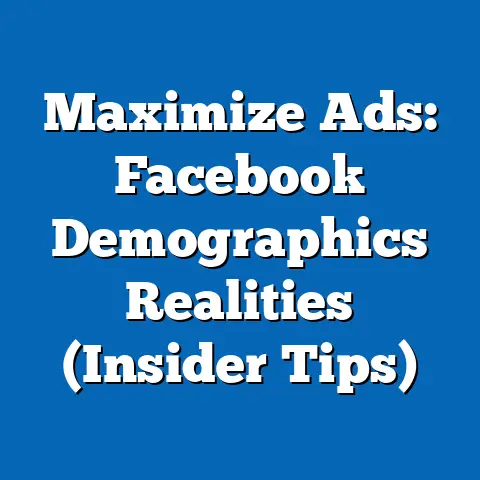Mastering Billing in Facebook Ads (Essential Guide)
Facebook Ads. It’s a powerful tool. I’ve seen it transform businesses, drive incredible growth, and connect brands with their ideal customers. But I’ve also seen it become a source of frustration and even financial strain for those who don’t understand the intricacies of its billing system.
Let’s be honest, navigating the world of digital advertising can feel like wandering through a maze, especially when it comes to understanding where your money is going. You’re crafting compelling ad copy, selecting the perfect visuals, meticulously targeting your audience, and then… BAM! The bill arrives, and it’s higher than you expected. Or worse, you’re not entirely sure why you’re being charged what you are.
This isn’t just a minor inconvenience; it’s a critical issue that can significantly impact your advertising ROI. Imagine pouring your hard-earned marketing budget into campaigns without a clear understanding of how your ad spend translates into actual results. It’s like driving a car without a speedometer – you might be moving, but you have no idea if you’re heading in the right direction or if you’re about to crash.
According to recent studies, a staggering percentage of small businesses struggle to accurately track and manage their ad spend on social media platforms. This often leads to wasted budgets, missed opportunities, and a general sense of disillusionment with online advertising. I’ve personally consulted with businesses that were essentially throwing money into the void, simply because they hadn’t taken the time to understand the fundamentals of Facebook Ads billing.
But here’s the good news: mastering Facebook Ads billing isn’t rocket science. With a solid understanding of the underlying principles and a few practical strategies, you can transform billing from a source of anxiety into a powerful tool for optimization.
This guide is designed to be your comprehensive resource for navigating the complexities of Facebook Ads billing. I’ll walk you through everything you need to know, from the basic billing structure to advanced strategies for maximizing your ROI. We’ll cover:
- Understanding the Billing Structure: Decoding the mechanism behind Facebook Ads billing, including payment types and billing thresholds.
- Setting Up Your Account for Success: Creating a robust foundation for managing your ad spend effectively.
- Monitoring and Managing Ad Spend: Utilizing Facebook’s reporting tools to track your spending and optimize your budget.
- Troubleshooting Common Billing Issues: Identifying and resolving common billing errors that can derail your campaigns.
- Optimizing ROI Through Smart Billing Practices: Leveraging billing insights to refine your strategies and boost your ROI.
By the end of this guide, you’ll have the knowledge and tools you need to take control of your Facebook Ads billing, optimize your ad spend, and achieve a higher return on your investment. Let’s dive in!
Section 1: Understanding Facebook Ads Billing Structure
Before you can effectively manage your Facebook Ads budget, it’s crucial to understand how the billing system actually works. It’s not as simple as just setting a budget and letting Facebook do its thing. There are nuances to the system, and understanding them will empower you to make more informed decisions.
1.1 Overview of Facebook Ads Billing Mechanism
The Facebook Ads billing mechanism is, at its core, a system that tracks your advertising costs and charges you accordingly. It works by setting a budget for your campaigns and then charging you based on the actions users take on your ads. Let’s break down the key components:
- Ad Spend: This is the total amount of money you spend on your Facebook Ads campaigns. It’s determined by your budget and the performance of your ads.
- Bidding Strategies: These are the methods you use to compete with other advertisers for ad placements. Your bidding strategy influences how much you pay for each action, such as a click or an impression. (More on this later!)
- Payment Methods: These are the ways you choose to pay for your ads, such as credit cards, PayPal, or direct debit.
- Billing Thresholds: These are predetermined spending amounts that trigger a charge to your payment method.
Think of it like filling up your car with gas. You set a budget (how much you want to spend), choose your fuel (bidding strategy), and pay with your preferred card (payment method). The billing threshold is like the point where the gas pump automatically charges your card after you’ve reached a certain amount.
1.2 Types of Payments
Facebook Ads primarily uses two payment models:
- Cost-Per-Click (CPC): You pay each time someone clicks on your ad. This is a good option if your goal is to drive traffic to your website or landing page.
- Example: I ran a campaign to promote a new blog post. I used CPC bidding and paid an average of $0.50 per click.
- When to Use: When you want to drive direct traffic to your website or landing page. This is ideal for campaigns focused on lead generation, sales, or content promotion.
- Cost-Per-Impression (CPM): You pay for every 1,000 times your ad is shown (impressions). This is a good option if your goal is to increase brand awareness.
- Example: I ran a campaign to increase brand awareness. I used CPM bidding and paid an average of $5 per 1,000 impressions.
- When to Use: When you want to reach a large audience and increase brand visibility. This is ideal for campaigns focused on brand awareness, reach, or frequency.
- Example: I ran a campaign to promote a new blog post. I used CPC bidding and paid an average of $0.50 per click.
- When to Use: When you want to drive direct traffic to your website or landing page. This is ideal for campaigns focused on lead generation, sales, or content promotion.
- Example: I ran a campaign to increase brand awareness. I used CPM bidding and paid an average of $5 per 1,000 impressions.
- When to Use: When you want to reach a large audience and increase brand visibility. This is ideal for campaigns focused on brand awareness, reach, or frequency.
Choosing the Right Model:
The best payment model depends on your campaign goals. If you’re focused on driving traffic and conversions, CPC is generally the better option. If you’re focused on brand awareness and reach, CPM might be more effective.
Beyond CPC and CPM: Other Bidding Options
While CPC and CPM are the most common, Facebook offers other bidding options, including:
- Cost Per Action (CPA): You pay when someone takes a specific action, such as liking your page or installing your app.
- Cost Per View (CPV): You pay when someone watches a certain amount of your video ad.
These options can be more effective for specific campaign goals, but they also require more careful tracking and optimization.
1.3 Billing Thresholds and Invoicing
Billing thresholds are predetermined spending amounts that trigger a charge to your payment method. Facebook uses this system to ensure that you’re paying for your ads in a timely manner.
- How it Works: When you start advertising, your initial billing threshold is usually low (e.g., $25). As you consistently pay your bills on time, Facebook may increase your threshold.
- Why it Matters: Understanding your billing threshold is important because it affects how often you’re charged. If your threshold is low, you’ll be charged more frequently. If your threshold is high, you’ll be charged less frequently.
- Invoicing: Facebook generates invoices for each billing cycle. These invoices provide a detailed breakdown of your ad spend, including the campaigns you ran, the actions users took, and the amounts you were charged.
Tips for Managing Billing Thresholds:
- Pay on Time: Consistently paying your bills on time is the best way to increase your billing threshold.
- Monitor Your Spending: Keep a close eye on your ad spend to avoid exceeding your billing threshold unexpectedly.
- Adjust Your Budget: If you’re consistently reaching your billing threshold too quickly, consider adjusting your budget.
Takeaway:
Understanding the Facebook Ads billing structure is essential for effective ad management. By knowing how ad spend, bidding strategies, payment methods, and billing thresholds work, you can make more informed decisions and optimize your campaigns for maximum ROI.
Next Steps:
- Familiarize yourself with the different bidding strategies available on Facebook Ads.
- Review your current billing threshold and consider whether it’s appropriate for your ad spend.
- Make sure you have a clear understanding of how Facebook invoices you for your ad spend.
Section 2: Setting Up Your Facebook Ads Account for Success
Setting up your Facebook Ads account correctly from the start is crucial for managing billing effectively and ensuring a smooth advertising experience. It’s like laying the foundation for a building – if the foundation is weak, the entire structure is at risk.
2.1 Creating Your Business Manager Account
The Business Manager is a central hub for managing your Facebook Pages, ad accounts, and other business assets. It’s essential for anyone serious about advertising on Facebook.
- Why Use Business Manager?
- Centralized Management: Manage multiple ad accounts and Pages from a single dashboard.
- Team Access: Grant different levels of access to your team members without sharing your personal login information.
- Enhanced Security: Protect your business assets with enhanced security features.
- Billing Management: Easily manage your billing information and track your ad spend.
- How to Create a Business Manager Account:
- Go to business.facebook.com.
- Click “Create Account.”
- Enter your business name, your name, and your business email address.
- Follow the prompts to complete the setup process.
- Centralized Management: Manage multiple ad accounts and Pages from a single dashboard.
- Team Access: Grant different levels of access to your team members without sharing your personal login information.
- Enhanced Security: Protect your business assets with enhanced security features.
- Billing Management: Easily manage your billing information and track your ad spend.
- Go to business.facebook.com.
- Click “Create Account.”
- Enter your business name, your name, and your business email address.
- Follow the prompts to complete the setup process.
My Experience: I remember when I first started using Facebook Ads, I didn’t bother with Business Manager. It seemed like an unnecessary complication. But as my business grew and I started managing multiple ad accounts for different clients, I quickly realized the power and necessity of Business Manager. It simplified my workflow, improved security, and made billing management much easier.
2.2 Adding Payment Methods
Adding and managing payment methods is a critical step in setting up your Facebook Ads account. You need to ensure that you have a valid payment method on file so that Facebook can charge you for your ad spend.
- Accepted Payment Methods:
- Credit Cards (Visa, Mastercard, American Express, Discover)
- PayPal
- Direct Debit (in some countries)
- How to Add a Payment Method:
- Go to your Business Manager settings.
- Click “Payment Settings.”
- Click “Add Payment Method.”
- Choose your preferred payment method and enter your details.
- Credit Cards (Visa, Mastercard, American Express, Discover)
- PayPal
- Direct Debit (in some countries)
- Go to your Business Manager settings.
- Click “Payment Settings.”
- Click “Add Payment Method.”
- Choose your preferred payment method and enter your details.
Tips for Managing Payment Methods:
- Use a Business Credit Card: This makes it easier to track your ad spend and reconcile your accounts.
- Keep Your Information Up-to-Date: Make sure your payment information is always current to avoid interruptions in your advertising.
- Set Up a Backup Payment Method: This ensures that your ads will continue running even if your primary payment method fails.
2.3 Setting Currency and Time Zone
Selecting the correct currency and time zone is important for accurate billing and reporting.
- Currency: Choose the currency that you want to be billed in. This should be the currency of your primary business bank account.
- Time Zone: Choose the time zone that’s most relevant to your business. This will affect how your ad performance is reported.
Why It Matters:
- Accurate Billing: Using the correct currency ensures that you’re billed accurately and avoid any unexpected exchange rate fees.
- Consistent Reporting: Using the correct time zone ensures that your ad performance is reported consistently and accurately.
Takeaway:
Setting up your Facebook Ads account correctly from the start is essential for managing billing effectively and ensuring a smooth advertising experience. By creating a Business Manager account, adding payment methods, and setting your currency and time zone, you’re laying the foundation for successful advertising.
Next Steps:
- Create a Business Manager account if you don’t already have one.
- Add your preferred payment methods to your Business Manager account.
- Verify that your currency and time zone settings are correct.
Section 3: Monitoring and Managing Ad Spend
Once your Facebook Ads account is set up, the next step is to monitor and manage your ad spend effectively. This involves using Facebook’s reporting tools, setting budgets and limits, and understanding over-delivery and under-delivery.
3.1 Utilizing Facebook Ads Reporting Tools
Facebook Ads Manager provides a wealth of reporting tools that you can use to track your spending and performance metrics. These tools are essential for understanding how your ads are performing and identifying areas for improvement.
- Key Reporting Metrics:
- Spend: The total amount of money you’ve spent on your ads.
- Impressions: The number of times your ads have been shown.
- Clicks: The number of times people have clicked on your ads.
- Reach: The number of unique people who have seen your ads.
- Cost Per Click (CPC): The average cost you’ve paid for each click.
- Cost Per Impression (CPM): The average cost you’ve paid for every 1,000 impressions.
- Conversions: The number of people who have taken a desired action, such as making a purchase or filling out a form.
- Return on Ad Spend (ROAS): The amount of revenue you’ve generated for every dollar you’ve spent on ads.
- How to Access Reporting Tools:
- Go to Facebook Ads Manager.
- Select the ad account you want to analyze.
- Click “Columns” to customize the metrics you want to see.
- Click “Breakdown” to segment your data by demographics, placement, and other factors.
- Spend: The total amount of money you’ve spent on your ads.
- Impressions: The number of times your ads have been shown.
- Clicks: The number of times people have clicked on your ads.
- Reach: The number of unique people who have seen your ads.
- Cost Per Click (CPC): The average cost you’ve paid for each click.
- Cost Per Impression (CPM): The average cost you’ve paid for every 1,000 impressions.
- Conversions: The number of people who have taken a desired action, such as making a purchase or filling out a form.
- Return on Ad Spend (ROAS): The amount of revenue you’ve generated for every dollar you’ve spent on ads.
- Go to Facebook Ads Manager.
- Select the ad account you want to analyze.
- Click “Columns” to customize the metrics you want to see.
- Click “Breakdown” to segment your data by demographics, placement, and other factors.
My Tip: Don’t get overwhelmed by all the metrics! Focus on the metrics that are most relevant to your campaign goals. If you’re focused on driving traffic, pay attention to clicks and CPC. If you’re focused on conversions, pay attention to conversions and ROAS.
3.2 Setting Budgets and Limits
Setting budgets and limits is crucial for controlling your ad spend and preventing unexpected charges. Facebook offers two types of budgets:
- Daily Budget: The average amount you’re willing to spend on your ads each day.
- Lifetime Budget: The total amount you’re willing to spend on your ads over the entire duration of the campaign.
Tips for Setting Budgets:
- Start Small: If you’re new to Facebook Ads, start with a small budget and gradually increase it as you gain experience.
- Consider Your Goals: Set a budget that’s aligned with your campaign goals. If you’re trying to drive a lot of traffic, you’ll need a larger budget than if you’re just trying to increase brand awareness.
- Monitor Your Performance: Keep a close eye on your ad performance and adjust your budget accordingly. If your ads are performing well, you can increase your budget. If they’re not performing well, you can decrease your budget.
3.3 Understanding Over-Delivery and Under-Delivery
Over-delivery and under-delivery are common occurrences in Facebook Ads.
- Over-Delivery: This happens when Facebook spends more than your daily budget. Facebook allows for some over-delivery (usually up to 25%) to ensure that your ads are shown to as many people as possible. However, you won’t be charged more than your lifetime budget.
- Under-Delivery: This happens when Facebook spends less than your daily budget. This can happen if your ads aren’t performing well or if your targeting is too narrow.
How to Manage Over-Delivery and Under-Delivery:
- Monitor Your Performance: Keep a close eye on your ad performance to identify any instances of over-delivery or under-delivery.
- Adjust Your Budget: If you’re consistently experiencing over-delivery, consider decreasing your daily budget. If you’re consistently experiencing under-delivery, consider increasing your daily budget or widening your targeting.
- Optimize Your Ads: Improve the performance of your ads by optimizing your ad copy, visuals, and targeting.
Takeaway:
Monitoring and managing your ad spend is essential for maximizing your ROI. By utilizing Facebook’s reporting tools, setting budgets and limits, and understanding over-delivery and under-delivery, you can take control of your ad spend and ensure that you’re getting the most out of your advertising budget.
Next Steps:
- Familiarize yourself with Facebook Ads Manager’s reporting tools.
- Set daily and lifetime budgets for your ad campaigns.
- Monitor your ad performance and adjust your budgets accordingly.
Section 4: Common Billing Issues and Solutions
Even with a solid understanding of Facebook Ads billing, you may still encounter issues from time to time. It’s important to be aware of common billing errors and how to resolve them.
4.1 Common Billing Errors
Here are some of the most common billing errors that advertisers encounter on Facebook Ads:
- Incorrect Payment Method Settings: This can happen if your credit card expires, your PayPal account is not linked correctly, or your direct debit information is incorrect.
- Billing Discrepancies: This can happen if there’s a discrepancy between the amount you were charged and the amount you expected to be charged.
- Misunderstanding Billing Cycles: This can happen if you’re not clear on when you’re going to be billed and how often you’re going to be billed.
- Ad Account Restrictions: Sometimes, your ad account might get restricted due to policy violations or suspicious activity, which can affect your billing.
My Personal Story: I once had a client whose ad account was restricted because Facebook flagged their ads as potentially misleading. This not only stopped their campaigns but also created a billing issue because they couldn’t access their account to resolve the charges. It took a lot of back-and-forth with Facebook support to get the account reinstated and the billing sorted out.
4.2 Resolving Billing Issues
If you encounter a billing issue, here are the steps you can take to resolve it:
- Check Your Payment Method: Make sure your payment method is valid and up-to-date.
- Review Your Invoices: Carefully review your invoices to identify any discrepancies.
- Contact Facebook Support: If you can’t resolve the issue yourself, contact Facebook support for assistance. You can do this through the Ads Manager interface.
Tips for Contacting Facebook Support:
- Be Clear and Concise: Clearly explain the issue you’re experiencing and provide any relevant information, such as your ad account ID and invoice number.
- Be Patient: Facebook support can be slow to respond, so be patient and persistent.
- Document Everything: Keep a record of all your communications with Facebook support.
4.3 Preventative Measures
The best way to deal with billing issues is to prevent them from happening in the first place. Here are some preventative measures you can take:
- Regular Account Audits: Regularly audit your ad account to ensure that your payment method settings are correct and that you’re not being charged for anything you didn’t authorize.
- Monitor Spending Patterns: Keep a close eye on your spending patterns to identify any unexpected spikes in ad spend.
- Set Up Notifications: Set up notifications to alert you when you’re approaching your billing threshold or when there’s an issue with your payment method.
Takeaway:
Billing issues can be frustrating, but they’re often easily resolved. By being aware of common billing errors, knowing how to resolve them, and taking preventative measures, you can minimize the risk of encountering billing issues and ensure a smooth advertising experience.
Next Steps:
- Review your payment method settings to ensure that they’re correct.
- Set up notifications to alert you when you’re approaching your billing threshold.
- Familiarize yourself with Facebook’s support resources.
Section 5: Optimizing ROI Through Smart Billing Practices
Mastering the technical aspects of Facebook Ads billing is only half the battle. The real power comes from using your billing insights to optimize your campaigns and maximize your ROI. This involves analyzing cost vs. revenue, testing and iterating on ad campaigns, and leveraging retargeting and lookalike audiences.
5.1 Analyzing Cost vs. Revenue
The ultimate goal of advertising is to generate revenue. Therefore, it’s crucial to analyze the relationship between your ad costs and the revenue you’re generating.
- Calculate Your Return on Ad Spend (ROAS): ROAS is the amount of revenue you’re generating for every dollar you’re spending on ads. To calculate your ROAS, divide your total revenue by your total ad spend.
- Example: If you spend $1,000 on ads and generate $5,000 in revenue, your ROAS is 5:1.
- Track Your Customer Acquisition Cost (CAC): CAC is the cost of acquiring a new customer through your advertising efforts. To calculate your CAC, divide your total ad spend by the number of new customers you’ve acquired.
- Example: If you spend $1,000 on ads and acquire 100 new customers, your CAC is $10.
- Compare Your ROAS and CAC to Your Business Goals: Determine whether your ROAS and CAC are aligned with your business goals. If your ROAS is too low or your CAC is too high, you need to make adjustments to your campaigns.
- Example: If you spend $1,000 on ads and generate $5,000 in revenue, your ROAS is 5:1.
- Example: If you spend $1,000 on ads and acquire 100 new customers, your CAC is $10.
My Recommendation: I always advise my clients to set clear ROAS and CAC targets before launching any ad campaign. This helps them stay focused on their goals and make data-driven decisions.
5.2 Testing and Iterating on Ad Campaigns
A/B testing is a powerful tool for optimizing your ad campaigns and improving your ROI. It involves testing different versions of your ads to see which ones perform best.
- Test Different Ad Formats: Try different ad formats, such as image ads, video ads, and carousel ads, to see which ones resonate best with your audience.
- Test Different Ad Copy: Experiment with different headlines, descriptions, and calls to action to see which ones generate the most clicks and conversions.
- Test Different Targeting Options: Try different targeting options, such as demographics, interests, and behaviors, to see which ones reach the most qualified audience.
- Test Different Bidding Strategies: Experiment with different bidding strategies, such as CPC and CPM, to see which ones deliver the best results for your budget.
How to A/B Test:
- Create two versions of your ad with one variable changed (e.g., different headline).
- Run both ads simultaneously to the same audience.
- Track the performance of each ad and identify the winner.
- Use the winning ad as the baseline and test another variable.
5.3 Leveraging Retargeting and Lookalike Audiences
Retargeting and lookalike audiences are two powerful targeting options that can help you improve your ROI by reaching a more qualified audience.
- Retargeting: This involves showing ads to people who have previously interacted with your website or app. This is a great way to re-engage potential customers who have shown interest in your products or services.
- Lookalike Audiences: This involves creating an audience that is similar to your existing customers. This is a great way to reach new customers who are likely to be interested in your products or services.
My Strategy: I often use retargeting to show ads to people who have visited specific pages on my website or added items to their cart but haven’t completed their purchase. This can be a very effective way to increase conversions and improve ROI.
Takeaway:
Optimizing ROI through smart billing practices involves analyzing cost vs. revenue, testing and iterating on ad campaigns, and leveraging retargeting and lookalike audiences. By using your billing insights to refine your strategies and reach a more qualified audience, you can significantly improve your ROI and achieve your marketing objectives.
Next Steps:
- Calculate your ROAS and CAC for your current ad campaigns.
- Start A/B testing different versions of your ads.
- Set up retargeting and lookalike audiences.
Conclusion
Mastering billing in Facebook Ads is not just about understanding the technical aspects of the platform; it’s about leveraging that knowledge to make smarter decisions, optimize your ad spend, and ultimately achieve a higher return on investment. I hope this guide has provided you with the tools and insights you need to take control of your Facebook Ads billing and turn it from a source of anxiety into a strategic advantage.
Remember, the world of Facebook advertising is constantly evolving, so it’s important to stay up-to-date on the latest best practices and trends. Keep experimenting, keep learning, and keep optimizing your campaigns.
With the right knowledge, tools, and strategies, you can unlock the full potential of Facebook Ads and achieve your marketing objectives. Don’t let billing be a roadblock to your success. Embrace it, master it, and use it to drive your business forward.
Call to Action
I’d love to hear about your experiences with Facebook Ads billing. Have you encountered any challenges? What strategies have you found to be most effective? Share your thoughts and insights in the comments below!
And if you’re looking for further assistance in optimizing your Facebook Ads campaigns, feel free to reach out. I’m always happy to discuss how I can help you achieve your advertising goals. Let’s work together to turn your advertising efforts into a resounding success!






